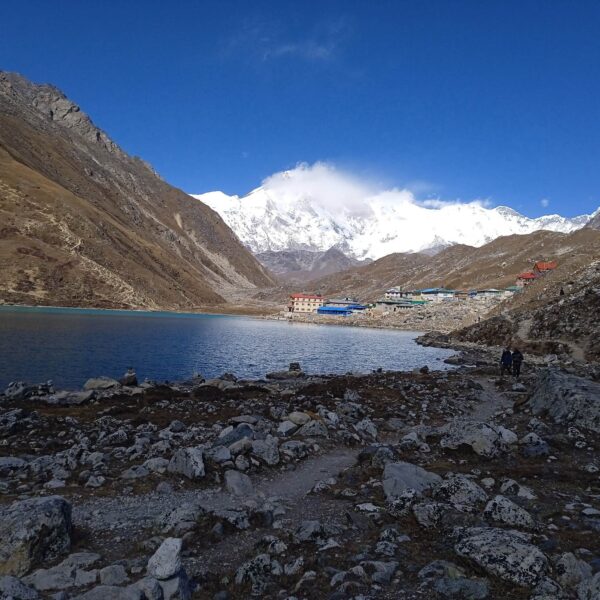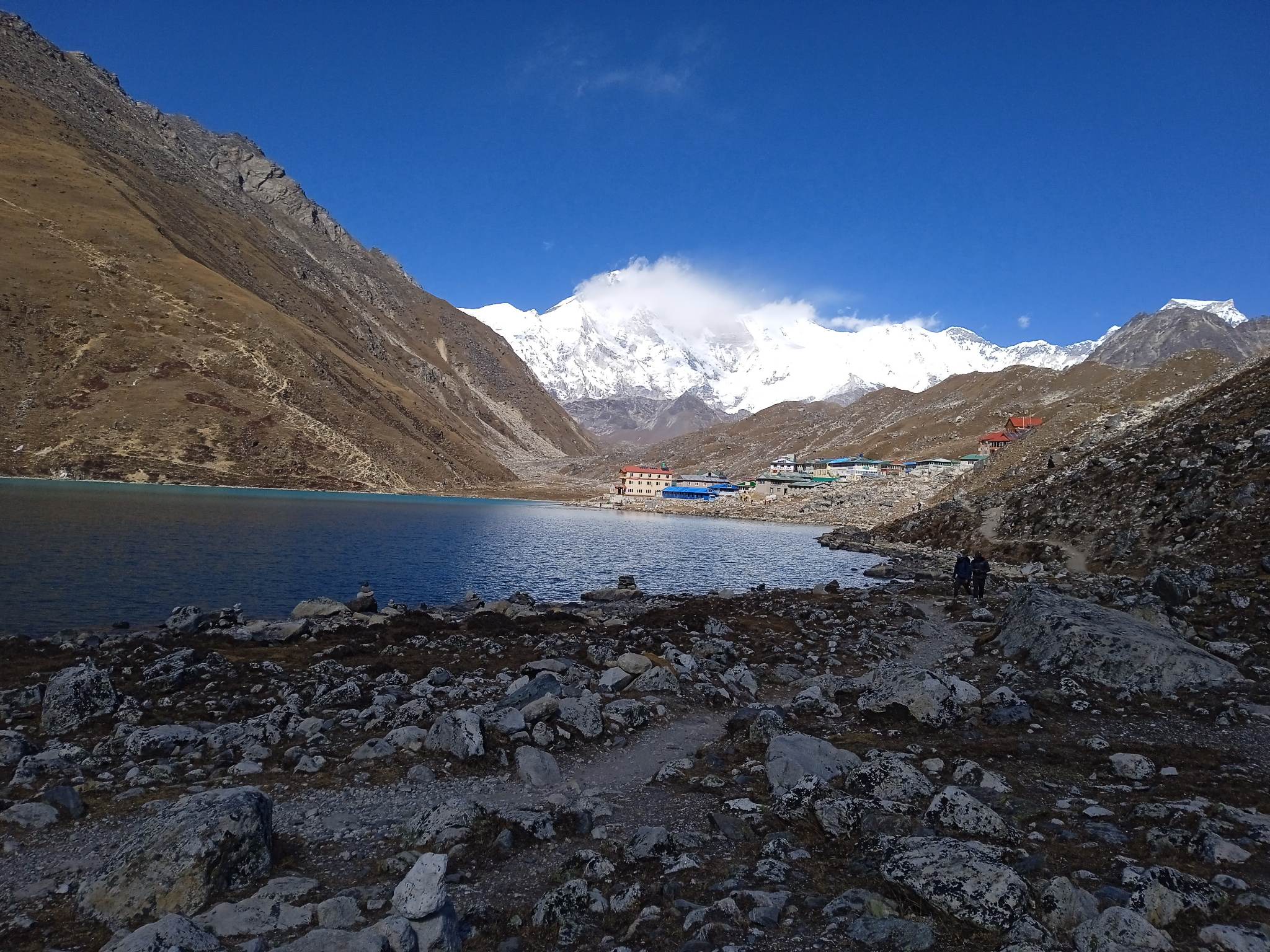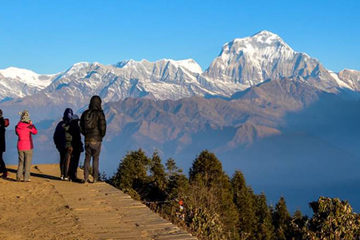 The Gokyo Lake Trek is a popular trekking route located in the Everest region of Nepal. It is an alternative trek to the classic Everest Base Camp trek and offers stunning views of the Himalayan peaks, including Mount Everest, as well as the beautiful Gokyo Lakes.
The Gokyo Lake Trek is a popular trekking route located in the Everest region of Nepal. It is an alternative trek to the classic Everest Base Camp trek and offers stunning views of the Himalayan peaks, including Mount Everest, as well as the beautiful Gokyo Lakes.
Here are some key points about the Gokyo Lake Trek:
- Route and Duration: The trek usually begins from Lukla, which is accessible by a short flight from Kathmandu. From Lukla, the trail follows the Dudh Koshi River valley, passing through several Sherpa villages, such as Namche Bazaar and Khumjung. The trek then ascends to the Gokyo Valley, where you’ll find a series of six glacial lakes. The duration of the trek is typically around 12-14 days, depending on the pace and acclimatization needs of the trekkers.
- Scenic Beauty: The Gokyo Lake Trek offers breathtaking natural beauty. Along the trail, you’ll encounter dense forests, suspension bridges, and vibrant rhododendron flowers (in the spring season). The highlight of the trek is reaching Gokyo Ri, a viewpoint situated at an elevation of 5,357 meters (17,575 feet), which offers panoramic views of Everest, Lhotse, Makalu, Cho Oyu, and the surrounding peaks.
- Gokyo Lakes: The Gokyo Lakes are a chain of high-altitude freshwater lakes, known for their turquoise color. The lakes are considered sacred by both Hindus and Buddhists. The largest lake, known as the Dudh Pokhari, is the most prominent and is surrounded by panoramic mountain views. The lakes are a serene and peaceful place, and many trekkers find them to be a highlight of the journey.
- Difficulty and Altitude: The Gokyo Lake Trek is considered moderately challenging. The trail involves steep ascents and descents, and the altitude can be demanding, especially as you approach Gokyo Ri. Proper acclimatization and physical fitness are essential for a safe and enjoyable trek. It is recommended to take enough rest days and maintain a gradual pace to prevent altitude sickness.
- Accommodation and Facilities: The trekking route has teahouses and lodges available for accommodation along the way. These establishments provide basic amenities such as meals, hot showers, and comfortable beds. However, as you gain elevation, the facilities become more basic and limited. It is advisable to carry some cash, as card payment options may be scarce.
- Best Time to Trek: The ideal time to undertake the Gokyo Lake Trek is during the spring (March to May) and autumn (September to November) seasons. These months offer stable weather conditions, clear skies, and excellent visibility. The spring season also showcases beautiful flowers in bloom, while the autumn season offers post-monsoon freshness.
Remember that trekking in the Everest region requires a permit from the Sagarmatha National Park and obtaining the necessary documentation is essential before starting the trek. Hiring a local guide or joining a trekking agency is highly recommended for a safe and organized experience.
Please note that the information provided here is based on general knowledge, and it’s always advisable to check with updated sources and consult experienced trekkers or local authorities for the latest information before planning your trek.
Trip Highlights
The Gokyo Lakes Trek is a popular trekking route in the Everest region of Nepal. It offers stunning views of the Himalayan mountain range, including Mount Everest, as well as the beautiful Gokyo Lakes.
The trek usually starts from the town of Lukla and follows a trail that passes through several Sherpa villages, lush forests, and scenic valleys. The main highlight of the trek is the series of turquoise-colored Gokyo Lakes, which are located at an altitude of about 4,700 to 5,000 meters (15,400 to 16,400 feet). The lakes are considered sacred by both Hindus and Buddhists and offer a breathtaking sight amidst the surrounding snow-capped peaks.
One of the main advantages of the Gokyo Lakes Trek is that it is less crowded compared to the more popular Everest Base Camp trek. However, it still provides a wonderful experience for trekkers, with panoramic views, unique landscapes, and encounters with the local Sherpa culture.
Along the route, you’ll have the opportunity to visit traditional Sherpa villages like Namche Bazaar, which is a vibrant trading hub in the region. You can also explore the famous Tengboche Monastery, which is one of the most important Buddhist monasteries in the Everest region.
The trek usually takes around 12 to 14 days to complete, depending on your pace and itinerary. It is essential to acclimatize properly to the high altitude to avoid altitude sickness. Hiring a local guide or joining a trekking group is recommended for a safer and more enjoyable experience.
Overall, the Gokyo Lakes Trek is a fantastic adventure that combines stunning natural beauty with cultural experiences in the Everest region of Nepal.
The trek offers breathtaking views of several majestic Himalayan peaks, including Mount Everest (8,848 meters/29,029 feet), Cho Oyu (8,201 meters/26,906 feet), Lhotse (8,516 meters/27,940 feet), and Makalu (8,481 meters/27,825 feet). The main highlight is the Gokyo Valley, known for its pristine glacial lakes, particularly the emerald-colored Gokyo Lake.
Day 1: Kathmandu to Lukla (2,800 meters/9,186 feet) to Phakding (2,652 meters/8,700 feet)
- Fly from Kathmandu to Lukla, a scenic mountain flight.
- Trek to Phakding, a small village along the Dudh Koshi River.
- Overnight stay in Phakding.
Day 2: Phakding to Namche Bazaar (3,440 meters/11,286 feet)
- Trek through beautiful pine forests along the Dudh Koshi River.
- Cross suspension bridges and reach the entrance of Sagarmatha National Park.
- Ascend steeply to Namche Bazaar, a vibrant Sherpa town and the gateway to the Everest region.
- Overnight stay in Namche Bazaar.
Day 3: Acclimatization day in Namche Bazaar
- Acclimatization day to adjust to the altitude.
- Take a short hike to the Everest View Hotel for panoramic views of Everest, Lhotse, Nuptse, and other mountains.
- Explore the colorful streets of Namche Bazaar, visit local shops, and interact with the Sherpa people.
- Overnight stay in Namche Bazaar.
Day 4: Namche Bazaar to Phortse Thanga (3,680 meters/12,073 feet)
- Trek along the trail with views of Everest and other peaks.
- Descend to the Dudh Koshi River and cross another suspension bridge.
- Ascend through rhododendron and pine forests to reach Phortse Thanga.
- Overnight stay in Phortse Thanga.
Day 5: Phortse Thanga to Machhermo (4,470 meters/14,665 feet)
- Continue trekking uphill and pass through villages and yak pastures.
- Enjoy the breathtaking views of Cho Oyu, Kantega, and Thamserku mountains.
- Reach the village of Machhermo, located near the river.
- Overnight stay in Machhermo.
Day 6: Machhermo to Gokyo (4,800 meters/15,748 feet)
- Ascend along the Dudh Koshi River valley.
- Pass through the villages of Pangka and Dole.
- Climb steeply to reach the scenic village of Gokyo, situated on the shores of the pristine Gokyo Lakes.
- Overnight stay in Gokyo.
Day 7: Hike to Gokyo Ri (5,357 meters/17,575 feet)
- Early morning hike to Gokyo Ri, a popular viewpoint for panoramic views of Everest, Cho Oyu, Lhotse, and other peaks.
- Descend back to Gokyo and spend the rest of the day exploring the Gokyo Lakes.
- Overnight stay in Gokyo.
Day 8: Gokyo to Dole (4,038 meters/13,248 feet)
- Descend back through Machhermo and Phortse Thanga.
- Reach the village of Dole, located amidst beautiful landscapes.
- Overnight stay in Dole.
Day 9: Dole to Namche Bazaar
- Continue descending through forests and villages.
- Reach Namche Bazaar, where you can enjoy some well-deserved rest and celebrate the completion of the trek.
- Overnight stay in Namche Bazaar.
Day 10: Namche Bazaar to Lukla
- Descend further to Lukla, retracing the trail.
Day11:Fly From Lukla To Kathmandu
International and domestic pick up and drop off by private car/Jeep/ Hiace.
2 night hotel accommodation with breakfast (B/B) in Kathmandu
All necessary papers including Everest national park permit and TIMS card (Trekking Information Management System)
Meals on a full-board basis (Breakfast, Lunch, and Dinner/ the main course) during the trek in the mountain.
Nature View Trek’s experienced, government-licensed, English-speaking trekking guide.
All salary, food, drinks, accommodation, transport, and insurance for the guide.
Trekking equipment such as the Sleeping bag, and down jacket on request (optional)
Trekking lodges (Tea House) throughout the trek
Airfare from Kathmandu – Lukla – Kathmandu.
Seasonal fresh fruits are desert every evening after dinner.
Appreciation of certificate after the successful trek.
Farewell Dinner at a typical Nepalese restaurant with traditional music and dance
Oximeter to measure your oxygen and Pulse level during the trek in the mountain.
Compressive first aid box (Guide will carry it throughout the trek).
Emergency rescue operation assistance in arranging in case of complex health conditions (funded by your Travel Insurance)
All government, Local taxes/ vat, and official expenses
Nepal entry Visa fees
Lunch and Dinner while in Kathmandu(2 days)
Kathmandu Sightseeing Tour
Your Travel Insurance
International Airfare and Airport Tax
Your Travel Insurance
All Drinks.
Personal things like postage, a hot water, internet, and laundry
Tips for guide & porter





Tour Reviews
There are no reviews yet.
Leave a Review